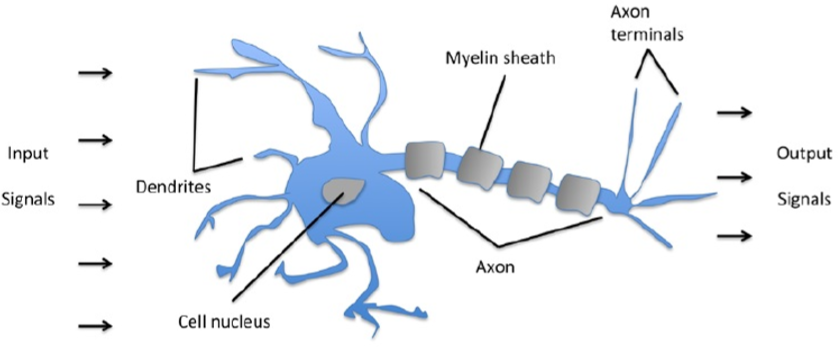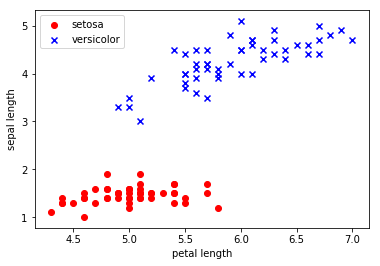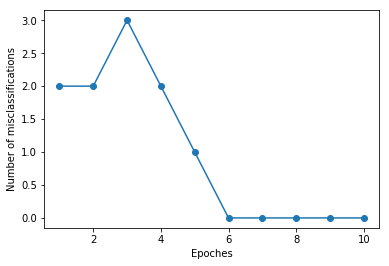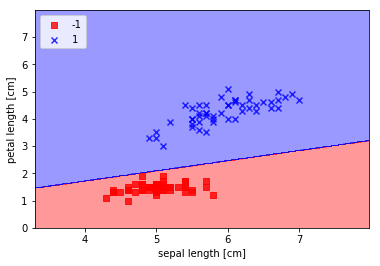python机器学习——感知器,,最近在看机器学习相关
python机器学习——感知器,,最近在看机器学习相关
最近在看机器学习相关的书籍,顺便把每天阅读的部分写出来和大家分享,共同学习探讨一起进步!作为机器学习的第一篇博客,我准备从感知器开始,之后会慢慢更新其他内容。
在实现感知器算法前,我们需要先了解一下神经元(neuron)的工作原理,神经元有很多树突和一个轴突,树突(Dendrites)可以从其他神经元接收信息并将其带到细胞体(Cell nucleus),轴突(Axon)可以从细胞体发送信息到其他神经元。树突传递过来的信息在细胞体中进行计算处理后,如果结果超过某个阈值,轴突会传递信号到其他的神经元。人们通过认识神经元的工作过程,创造出了感知器学习算法。

感知器是Frank Rosenblatt在1975年就职于康奈尔实验室时所发明的一种人工神经网络,它被视为一种最简单形式的前馈神经网络,是一种二元线性分类器,不足在于不能处理线性不可分问题。
下图为三种不同情况,左图中的两类可以使用一条直线(即线性函数)分开,即线性可分;中间和右边由于不能使用线性函数分开,则为线性不可分。

我们直接来看一个实例,假设我们现在需要对花进行分类,数据集中有两种花朵,分别将其记为1和-1,我们需要根据数据集含有的花的一些特征来进行分类,这里仅使用两种花的特征,即萼片长度和花瓣长度,将这两个特征用向量表示为:
x也叫做输入向量,我们再定义一个相应的权重向量w:
将x和w线性组合后得到z:
我们假设,如果样本的激活值z大于等于事先设置好的阈值b,我们就说此样本属于类别1,否则属于类别-1,公式表示如下:
可以看出这个想法和神经元的工作原理很相似。为了方便,我们将阈值b移到等式的左边并额外定义一个权重参数来代替-b,更新z为以下等式:
那么上式中的z大于等于0的情况也就等价于之前当z大于等于阈值b的情况,可以得到:
上面的函数也叫做激活函数,我们通过激活函数将z压缩到了一个二元输出(1,-1),也就是:

我们可以看出权重向量w决定着分类是否准确,那么我们如何选择合适的权重向量w呢?我们不能一个一个给w赋值,这样工作量太大且没有效率,其实感知器可以通过数据集中的样本自动调整w,随着训练的进行,w的变化趋于平稳,分类的准确率也会大大提高。
我们更新权重向量w的公式为:
其中学习率介于0.0和1.0之间,用于控制w更新的程度,权重向量w中的每一个参数都是同步更新的,即只有在w的每个参数的更新大小都计算出来后才会改变w的值,我们使用数据集中的大量训练样本x来更新w,来逐渐提高分类准确率。
感知器算法只有类别线性可分且学习率较小的情况下才能保证收敛,感知器接收训练样本x,将x与w线性结合得到z,再将z传递给激活函数,产生一个分类结果作为对样本x的预测类别,之后按照更新规则来更新w,等收敛后感知器也就训练完成了。
接下来我们开始实现感知器算法并使用Iris数据集训练:
import pandas as pd读取数据集
df = pd.read_csv(‘http://archive.ics.uci.edu/ml/machine-learning-databases/iris/iris.data‘, header=None)df.tail()| 0 | 1 | 2 | 3 | 4 | |
|---|---|---|---|---|---|
| 145 | 6.7 | 3.0 | 5.2 | 2.3 | Iris-virginica |
| 146 | 6.3 | 2.5 | 5.0 | 1.9 | Iris-virginica |
| 147 | 6.5 | 3.0 | 5.2 | 2.0 | Iris-virginica |
| 148 | 6.2 | 3.4 | 5.4 | 2.3 | Iris-virginica |
| 149 | 5.9 | 3.0 | 5.1 | 1.8 | Iris-virginica |
由上表可以看到每个输入向量x都包含4个特征(0、1、2、3)和1个正确的类别(4)
%matplotlib inlineimport numpy as npimport matplotlib.pyplot as pltimport pandas as pd取出前100个训练样本的类别向量,若其类别输入‘Iris-setosa’,则将其设置为-1,否则设置为1
y = df.iloc[0:100, 4].valuesy = np.where(y == ‘Iris-setosa‘, -1, 1)取出前100个训练样本的前两个特征向量
X = df.iloc[0:100, [0, 2]].values画出这100个训练样本的类别分布图
plt.scatter(X[:50, 0], X[:50, 1], color=‘red‘, marker=‘o‘, label=‘setosa‘)plt.scatter(X[50:100, 0], X[50:100, 1], color=‘blue‘, marker=‘x‘, label=‘versicolor‘)plt.xlabel(‘petal length‘)plt.ylabel(‘sepal length‘)plt.legend(loc=‘upper left‘)plt.show()
实现感知器
import numpy as npclass Perceptron(object): """Perceptron classifier. Parameters ---------- eta:float Learning rate(between 0.0 and 1.0 n_iter:int Passes over the training dataset. Attributes ---------- w_:1d-array weights after fitting. errors_:list Number of miscalssifications in every epoch. """ def __init__(self, eta=0.01, n_iter=10): self.eta = eta self.n_iter = n_iter def fit(self, X, y): """Fit training data. :param X:{array-like}, shape=[n_samples, n_features] Training vectors, where n_samples is the number of samples and n_features is the number of features. :param y: array-like, shape=[n_samples] Target values. :return: self:object """ self.w_ = np.zeros(1 + X.shape[1]) # Add w_0 self.errors_ = [] for _ in range(self.n_iter): errors = 0 for xi, target in zip(X, y): update = self.eta * (target - self.predict(xi)) self.w_[1:] += update * xi self.w_[0] += update errors += int(update != 0.0) self.errors_.append(errors) return self def net_input(self, X): """Calculate net input""" return np.dot(X, self.w_[1:]) + self.w_[0] def predict(self, X): """Return class label after unit step""" return np.where(self.net_input(X) >= 0.0, 1, -1) #analoge ? :n in C++ppn = Perceptron(eta = 0.1, n_iter = 10)ppn.fit(X, y)<__main__.Perceptron at 0x16680906978>画出训练曲线
plt.plot(range(1, len(ppn.errors_) + 1), ppn.errors_, marker = ‘o‘)plt.xlabel(‘Epoches‘)plt.ylabel(‘Number of misclassifications‘)plt.show()
画出分界线
from matplotlib.colors import ListedColormapdef plot_decision_region(X, y, classifier, resolution=0.02): # setup marker generator and color map markers = (‘s‘, ‘x‘, ‘o‘, ‘^‘, ‘v‘) colors = (‘red‘, ‘blue‘, ‘lightgreen‘, ‘gray‘, ‘cyan‘) cmap = ListedColormap(colors[:len(np.unique(y))]) # plot the decision surface x1_min, x1_max = X[:, 0].min() - 1, X[:, 0].max() + 1 x2_min, x2_max = X[:, 1].min() - 1, X[:, 0].max() + 1 xx1, xx2 = np.meshgrid(np.arange(x1_min, x1_max, resolution), np.arange(x2_min, x2_max, resolution)) Z = classifier.predict(np.array([xx1.ravel(), xx2.ravel()]).T) Z = Z.reshape(xx1.shape) plt.contourf(xx1, xx2, Z, alpha=0.4, cmap=cmap) plt.xlim(xx1.min(), xx1.max()) plt.ylim(xx2.min(), xx2.max()) #plot class samples for idx, cl in enumerate(np.unique(y)): plt.scatter(x=X[y == cl, 0], y=X[y == cl, 1], alpha=0.8, c=cmap(idx), marker = markers[idx], label=cl)plot_decision_region(X, y, classifier=ppn)plt.xlabel(‘sepal length [cm]‘)plt.ylabel(‘petal length [cm]‘)plt.legend(loc=‘upper left‘)plt.show()
参考:
https://www.toutiao.com/a6669391886744027662/
https://zh.wikipedia.org/wiki/%E6%84%9F%E7%9F%A5%E5%99%A8
出处:https://www.cnblogs.com/Dzha/p/11832453.html
python机器学习——感知器
相关内容
- python中字典,python访问字典,字典中key:不可改
- Python-网络编程,python网络编程基础,一、使用python
- Python内置函数,Python常用内置函数,abs() 获取绝对
- python 使用 requests 做 http 请求,python3requests,1. getimpo
- python matplotlib模块——绘制三维图形、三维数据散点图
- Python 实现红绿灯,红绿灯怎么看,一、通过Event来
- python读csv格式文档并用matplotlib绘制图表,pythonmatplot,
- Python绘制五星红旗,什么的五星红旗,# -*- codi
- 小白学 Python(2):基础数据类型(上),,人生苦短,
- python二进制转换,python将十进制转为二进制,题目描述:
评论关闭